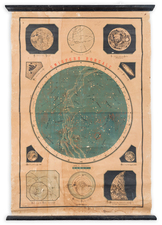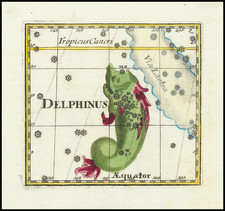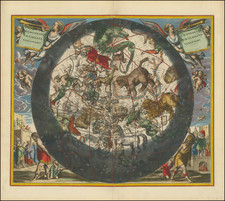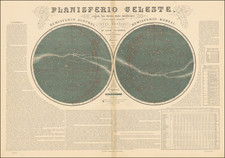MODERN REPRODUCTION--IMAGE IS POSTED ONLY FOR EDUCATIONAL PURPOSES:
Reproduction of the second state of this striking chart of the Northern Sky, illustrating the constellations of the Southern Hemisphere superimposed over the earth's Southern Hemisphere, from Andreas Cellarius's Harmonia Macrocosmica, first publshed in 1660.
Note Regarding Reproduction:
This is a modern reproduction. The easiest way to spot this reproduction is the printed plate mark at the to left corner (no impression, just ink). Under there is no plate mark.
The majority of reproductions of this map that we have seen including Janssonius as the maker in the lower part of the map. While Janssonius (Johannes Jansson) was the publisher of the 1660 and 1661 editions of this atlas, Janssonius' name never appeared on the 1660 or 1661 editions of the printed maps. In the early 18th Century (1708), the Cellarius plates were acquired by Valk & Schenk, who added their names to each of the maps and re-issued the atlas, without the text.
Historical Overview of the Map
The map provides a fantastic image of the stars, as if seen from deeper in space, so that each of the constellations is facing in the opposite direction from the way that the same constellations would be seen from earth. This projection reflects a theory which originated with Petrus Plancius that the stars remained in a sphere-like configuration above the earth, which moved in coordination with the earth. This theory is found in the title of his atlas, Harmonia Macrocosmica.
Andreas Cellarius was born in 1596 in Neuhausen and educated in Heidelberg. He emigrated to Holland in the early 17th Century and 1637 moved to Hoorn, where he became the rector of the Latin School. Cellarius' best known work is his Harmonia Macrocosmica, first issued in 1660 by Jan Jansson, as a supplement to Jansson's Atlas Novus. The work consists of a series of Celestial Charts begun by Cellarius in 1647 and intended as part of a two volume treatise on cosmography, which was never issued.
Cellarius' charts are the most soughtafter of celestial charts, blending the striking imagery of the golden age of Dutch Cartography with contemporary scientific knowledge.
Andreas Cellarius was born in 1596 in Neuhausen and educated in Heidelberg. He emigrated to Holland in the early 17th century, and in 1637 moved to Hoorn, where he became the rector of the Latin School. Cellarius' best-known work is his Harmonia Macrocosmica, first issued in 1660 by Jan Jansson, as a supplement to Jansson's Atlas Novus. The work consists of a series of Celestial Charts begun by Cellarius in 1647 and intended as part of a two-volume treatise on cosmography, which was never issued.










![Hemisphere Austral [and] Hemisphere Boreal](https://storage.googleapis.com/raremaps/img/small/81984.jpg)

![Globi Coelestis In Tabulas Planas Redacti Pars II . . . [Pegasus, Capricorn, Aquarius, Pisces Cetus, Aries, Andromeda, Equuleus]](https://storage.googleapis.com/raremaps/img/small/71151.jpg)

